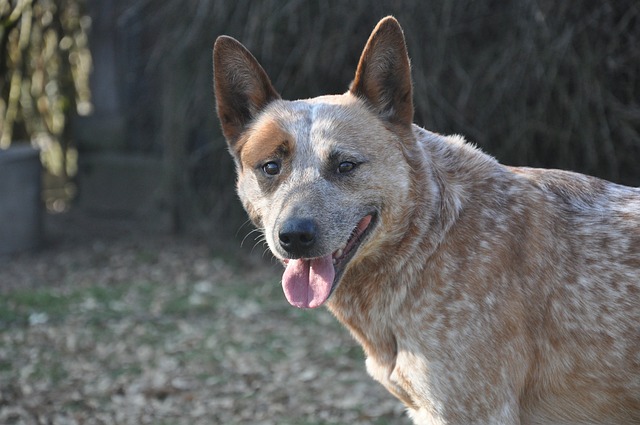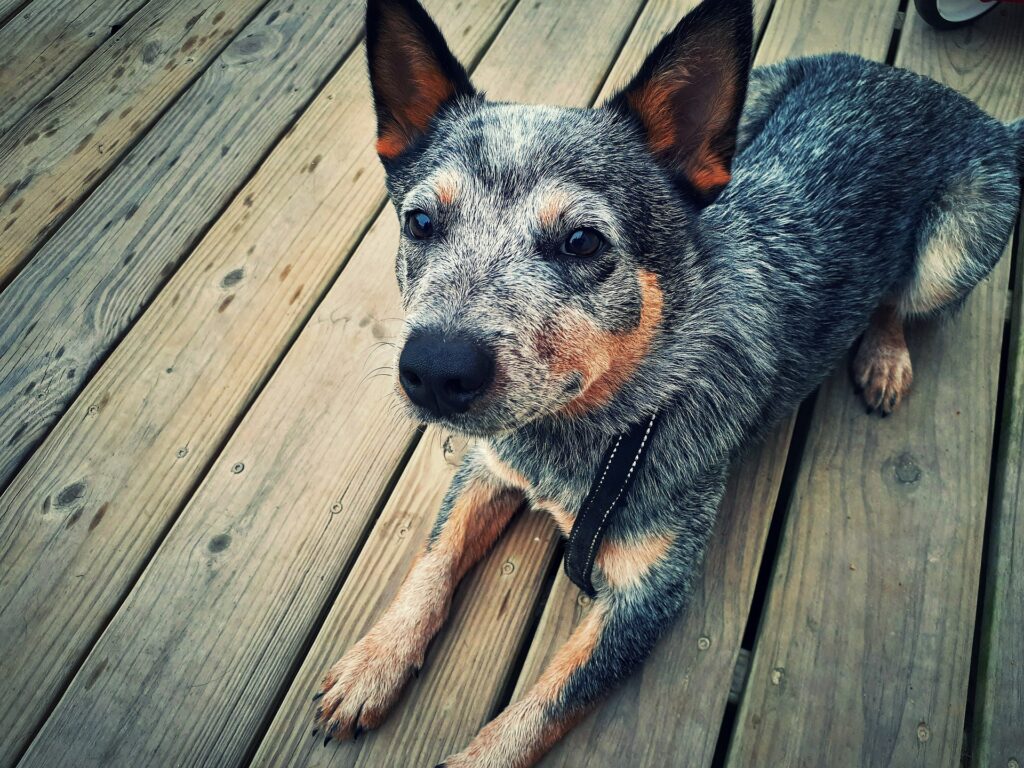The Blue Heeler, or Australian Cattle Dog, is an amazing dog breed known for their high energy and loyalty. Most owners do not want to think about the mortality of their dog but it is important to know. So how long do Blue Heelers live?
Blue Heelers live for 12-16 years on average. Diseases like hip dysplasia, eye and heart problems, and deafness may make their lives harder. But there are things you can do to help your dog live longer.
- How Long Do Australian Cattle Dogs Live?
- What Health Issues Do Blue Heelers Have?
- Maintaining Blue Heeler Longevity
- What Is The Oldest Living Blue Heeler?
How Long Do Australian Cattle Dogs Live?
The average lifespan of an Australian Cattle Dog is around 12-16 years. They are relatively healthy dogs with athletically built bodies.
The Australian Cattle Dog is also called a Blue Heeler, Red Heeler, and Queensland Heeler. It descends from the Australian Dingo and the Smithfield Sheepdog. Dingoes were wild dogs built with strong bodies and high stamina. These breed characteristics, along with the fact that Blue Heelers were herding dogs, gave them high energy to use. The fact that these dogs used their high energy to run around all day kept their health levels high.
The size of the dog also affects the average canine lifespan. Smaller breeds are usually the longest-living. Blue Heelers are medium-sized dogs and will live longer compared to big dogs.
What Health Issues Do Blue Heelers Have?
Australian Cattle Dogs are healthy dogs, but they should be regularly screened for a few diseases. Eye problems like Progressive Retinal Atrophy and Cataracts are common in these dogs. Bloat and Deafness are some other things you can screen for. But there are a few other diseases to keep an eye on.
Bloat
Gastric Dilatation Volvulus (GDV), or Bloat, is a gastrointestinal disorder common in many dog breeds. This disease can be life-threatening and greatly affect the Blue Heeler lifespan.
This health issue is common in deep-chested dogs like the Blue Heeler. It happens when the stomach fills with gas dilating it in the process. Sometimes, the gas-filled stomach twists upon itself and causes a blockage called a volvulus. Some symptoms you may notice in the dog include:
- Vomiting
- Constipation
- Painful and distended abdomen
- Hypersalivation
These symptoms can occur quickly and progress fast, so the dog will need immediate veterinary help.
Hip Dysplasia
Even though this illness is more common in larger dogs, Blue Heelers can still suffer from it. Hip dysplasia is an inherited disease of the musculoskeletal system. It affects the dog’s hind legs, but a similar disease called elbow dysplasia will affect the front legs.
It happens because of a misalignment in the ball and socket joint. The femoral head does not fit in the pelvic socket causing problems with walking. In time, it can lead to arthritis.
This disease will not directly affect the life expectancy of Blue Heelers but it will greatly affect their quality of life.
Cataracts
This is an eye disease that affects the lens of the eye. It can occur as a disease of the canine’s genetics or be caused by other factors. Diabetes, trauma, and dog aging can all be a cause of cataracts.
Everything happens because the lens of the eye starts getting cloudy due to the clumping of its proteins. This cloudiness will increase in time causing more vision problems for the dog. The disease follows a few stages depending on the amount of visual impairment. In time, the dog won’t be able to see anything anymore and essentially become blind.
Progressive Retinal Atrophy
Another eye disease common in dogs is Progressive Retinal Atrophy. This is a hereditary disease that affects the retina of the eye. Essentially it is a degeneration of the photoreceptor cells of the retina.
The first sign of this disease is usually night blindness. You will notice the dog having problems finding its way in the dark and being reluctant to enter dark rooms. In time, the vision will worsen during the day too, and lead to complete blindness.
This is another disease that does not shorten the Blue Heeler lifespan but greatly affects the quality of life of the dog.
Heart Problems
There are a few heart problems that can affect Blue Heelers. One of those is called Dilated Cardiomyopathy. This disease happens because of a degeneration of the heart muscle walls which causes them to become thin. Once thinned, the walls dilate and can lead to Congestive Heart Failure.
A lot of heart problems lead to heart failure and there are a few symptoms any owner can notice. These include:
- Distended abdomen
- Peripheral edema
- Coughing and difficulty breathing
- Lethargy and weakness
- Collapse and fainting
Congestive Heart Failure can also be caused by Mitral Valve Insufficiency. Heart failure needs to be treated by a vet.
Deafness
Dogs can become deaf due to inherited pet genetics. But some illnesses can also cause deafness in dogs. Blockage of the ear canal, rupturing of the eardrums, or inflammation of the middle and inner ear can all cause deafness.
A noticeable sign of deafness is when the dog doesn’t respond to sounds. It may not do a command you give or not come when you call it. Unusual animal behaviors like excessive barking, hyperactivity, and an unusual voice will also be present. This disease will not affect the lifespan of Australian Cattle Dogs but it will greatly affect their quality of life.
Maintaining Blue Heeler Longevity
There are things you can do to prolong your pet’s longevity. These include good pet care, nutrition, grooming, and exercise.
Proper Pet Nutrition
The type and amount of food you give to your dog will greatly affect the animal’s longevity and health. Australian Cattle Dogs need around 2-3 cups of dog food a day. This amount should be spread out during the whole day.
All healthy dog food should be filled with protein, as well as vitamins, minerals, fiber, and healthy fatty acids. Dog food should be low in grains and artificial ingredients that may harm the dog. Make sure the company that makes the dog food is known for being reliable. Also, choose dog food meant for medium-sized dogs as Blue Heelers are of that size.
Regular Grooming
You can increase the Blue Heeler mortality expectancy by maintaining a regular grooming routine. Blue Heelers need their coat brushed once or twice a week. These dogs will shed throughout the year and regular brushing will reduce this shedding.
These dogs will also need to be bathed once a month. Bathing too much may damage the skin and coat of the dog. Brushing too little will cause a bad smell and the possibility of infection. Dogs will also need their nails clipped and ears cleaned regularly. Their teeth should also be brushed regularly to maintain good oral hygiene.
Daily Exercise
These dogs were bred as herding dogs so they have a naturally high energy that needs spending. In fact, Blue Heelers calm down at 4-6 years of age. So owners will have to deal with a hyperactive dog for many years before it finally calms down a bit.
Blue Heelers need around 2 hours of exercise every day. This should be split into more sessions during the morning and evening. You can take the dog for a walk, run, hike, or play some fun bonding games. Exercising helps maintain good health while preventing destructive behavior and anxiety. Dog training can also be a part of the exercise.
What Is The Oldest Living Blue Heeler?
The oldest living Blue Heeler was named Bluey and it lived to be 29 years and 5 months old. This is almost double the average lifespan of Blue Heelers. This dog is actually the oldest living dog in the world. There’s little information about this dog and why it lived for so long.
For one, Bluey was a female dog and we know that the Blue Heeler life cycle is longer in females. This dog was born in 1910 in Rochester, Australia, where it worked as a herding dog for two decades. This active pet lifestyle may have contributed to its long lifespan. Then, the dog lived until 1939, and until recently it was the longest-living dog in the world according to the Guinness World Records. This record was broken in 2023 by a dog named Bobi.

Final Thoughts – How Long Do Blue Heelers Live?
The average Blue Heeler aging expectancy is around 12-16 years according to the AKC. These dogs stay healthy throughout their lifespan due to their high energy levels and size. But there are still a few diseases that Australian Cattle Dogs can have.
One common health problem in dogs is hip dysplasia. This disease affects the movement of the dog but does not directly affect the dog’s aging process. Other such diseases include cataracts, progressive retinal atrophy, and deafness. Heart problems and bloat are much more dangerous and will affect the Blue Heeler aging process.
To help your dog live longer and be healthier, you can do a few things. Feeding a proper diet, maintaining a healthy exercise routine, and regular grooming will help a lot in the long run.
FAQ
Are Blue Heelers good family pets?
Blue Heelers make for great family pets. Because they were bred as working dogs, they developed a lot of affection and loyalty to their owners. They will also get along with kids due to their high energy and curiosity.
Do Blue Heelers protect their owners?
Blue Heelers are very protective and territorial and this makes them great guard dogs. We explained how long Blue Heelers live, so you can expect your Blue Heeler to protect you for all its lifetime.
Do Blue Heelers pick a favorite person?
Yes, Blue Heelers will choose one person as their favorite. Usually, this is the person they deem the dominant in the pack or the family. But the dog will love all other family members and get along with them greatly.
The Blue Heeler Husky Mix: A Remarkably Hardworking Dog
Blue Heelers, or Australian Cattle Dogs, and Siberian Huskies are two dogs known for their…
How Long Do Blue Heelers Live? – A Surprisingly Lengthy Life
The Blue Heeler, or Australian Cattle Dog, is an amazing dog breed known for their…
When Do Blue Heelers Calm Down? – How To Help Them
The Australian Cattle Dog, or the Blue Heeler, is a working dog created specifically to…
How Big Do Blue Heelers Get? Informative Answer And Advice
Blue Heelers are also referred to as Australian Cattle Dogs, Red Heelers, or Queensland Heelers….
Characteristics Of The Fascinating Jack Russell Blue Heeler Mix
The Jack Russell Terrier and the Australian Cattle Dog, or Blue Heeler, are amazing dogs….







